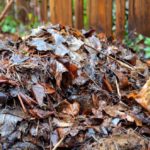
Front yard topped with wood chips around all of our perennial flowers, ornamental grasses, trees and shrubs
Mulch is added to the top of your plant beds – not mixed or tilled into the soil. It sits on top of your soil to help retain moisture, suppress weeds and slowly decompose, which helps improve soil structure over time. We don’t use it in our raised beds, where we intensively grow vegetables – we just add compost here regularly and hand weed often. Our wood chip mulch gets added to every other corner of the homestead though to help it flourish.
I’ve heard some folks argue that using wood chips actually takes nutrients, particularly nitrogen, away from your plants. The answer to that is a bit more complicated and really based on how you’re applying the wood chips to your garden. Tilling wood chips into your soil will tie up some nutrients, but top-dressing (like I’m recommending) doesn’t have the same effect. Read this article from OSU Extension for a more thorough answer: Wood chips for mulch?
We used ChipDrop again this year to get a fresh mound of wood chips delivered to our home from a local arborist for free. The wood chips are more varied in size than if you bought from from a soil supplier, but the price is right! The larger the pieces, the longer it will take them to decompose, so we can get away with adding wood chips every 2-3 years as needed.
Eventually the wood chips will decompose and once they have fully broken down it is safe to dig them into your soil. At that point, the organic material has already broken down, worms have helped the process along and bacteria won’t be sequestering nutrients (particularly nitrogen). It’s a great long-term, natural and inexpensive method of improving sandy soil or heavy clay soil. It takes time and patience, but the pay off will be worth it: fluffy soil with good “loam” consistency that makes it easy for plants to grow deep roots, store water and air, plus room for micro organisms to make a home.

Finishing up the last of the wood chip pile. We spread a tarp out with cones to mark the spot where the arborists should drop our wood chip load.
It’s not too late for you to get your homestead whipped into shape with wood chips. Call around to local arborists or sign up with ChipDrop if they operate in your area. I specify no walnut trees, which can be toxic to other plants. Or add this to your fall to do list when you are cleaning up the garden for winter. That’s also a good time to layer in dried leaves and top off with wood chips. Read more about Using Dried Leaves in this earlier post. Happy mulching!






 This has become my
This has become my
 This is from South
This is from South


 All the ornamental grasses get cu
All the ornamental grasses get cu



Thanks for the info. I just dug my strawberry bed and I wanted to top it with woodchips. Nice to know I can.